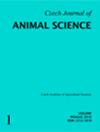Micelle silymarin supplementation to fattening diet augments daily gain, nutrient digestibility, decreases toxic gas emissions, and ameliorates meat quality of fattening pigs
IF 1.4
4区 农林科学
Q3 AGRICULTURE, DAIRY & ANIMAL SCIENCE
引用次数: 2
Abstract
To evaluate the impact of micelle silymarin (MS) on fattening pig growth, nutrient digestibility, toxic gas emissions and meat quality, 140 crossed fattening pigs were allocated to four treatments with seven repetition pens [(two barrows and three gilts)/pen] per treatment from the initial body weight of 51.0 kg (SD 2.86). The pigs were fed the basal diet containing 0%, 0.05%, 0.1%, and 0.2% MS for 10 weeks. The results showed a linear improvement in the average daily gain (ADG) of pigs during 5 to 10 weeks as the dietary MS dose increased (P = 0.041). The apparent total tract digestibility of nitrogen (N) was enhancive linearly (P = 0.017 and 0.031, respectively) in week 5 and week 10 as the dietary MS dose increased. The Lactobacillus populations in the faeces of pigs fed MS diets were linearly increased (P = 0.048) during week 5. The dietary supplement of MS decreased faecal H2S concentrations in week 5 and NH3 concentrations in week 10 (quadratic, P = 0.022 and 0.007, respectively). Moreover, dietary MS linearly diminished cooking loss (P = 0.010) and yellowness value at 45 min postmortem (P = 0.029), whereas the redness value linearly increased (P = 0.028 and 0.002, respectively) after 45 min and 24 h postmortem. Finally, the linear decrease (P < 0.001) of thiobarbituric acid reactive substance (TBARS) concentration and protein carbonyl in pigs fed MS diets was found, but a quadratic improvement (P < 0.031) of total antioxidant capacity (T-AOC) concentration was observed in the meat samples from MS-treated pigs. Taken together, supplementation of the graded level of MS to the basal diet exhibited dose-independent responses on ADG, N digestibility, toxic gas emissions and meat quality. Among the tested doses, 0.2% MS supplementation in the diet is found to be the most effective dose.饲粮中添加胶束水飞蓟素可提高育肥猪日增重,提高营养物质消化率,减少有毒气体排放,改善肉质
为了评估胶束水飞蓟素(MS)对育肥猪生长、营养物质消化率、有毒气体排放和肉质的影响,将140头杂交育肥猪从初始体重51.0kg(SD 2.86)分配到4个处理,每个处理7个重复围栏[(2头公猪和3头母猪)/围栏],和0.2%MS持续10周。结果表明,在5至10周期间,随着日粮MS剂量的增加,猪的平均日增重(ADG)呈线性改善(P=0.041)。在第5周和第10周,氮的表观总消化率呈线性增强(分别为P=0.017和0.031)。在第5周,饲喂MS日粮的猪粪便中的乳杆菌种群线性增加(P=0.048)。MS的膳食补充剂降低了第5周的粪便H2S浓度和第10周的NH3浓度(二次方,分别为P=0.022和0.007)。此外,在死后45分钟,膳食MS线性降低了烹饪损失(P=0.010)和黄度值(P=0.029),而在死后45min和24h,红度值线性增加(分别为P=0.028和0.002)。最后,在饲喂MS的猪中,硫代巴比妥酸反应物质(TBARS)浓度和蛋白质羰基呈线性下降(P<0.001),但在MS处理的猪的肉样品中,总抗氧化能力(T-AOC)浓度呈二次型改善(P<0.031)。总之,在基础日粮中添加分级水平的MS对ADG、N消化率、有毒气体排放和肉质表现出剂量依赖性反应。在测试的剂量中,发现在饮食中补充0.2%的MS是最有效的剂量。
本文章由计算机程序翻译,如有差异,请以英文原文为准。
求助全文
约1分钟内获得全文
求助全文
来源期刊

Czech Journal of Animal Science
Agriculture, Dairy & Animal Science-奶制品与动物科学
CiteScore
2.40
自引率
16.70%
发文量
44
审稿时长
5 months
期刊介绍:
Original scientific papers and critical reviews covering all areas of genetics and breeding, physiology, reproduction, nutrition and feeds, technology, ethology and economics of cattle, pig, sheep, goat, poultry, fish and other farm animal management. Papers are published in English.
 求助内容:
求助内容: 应助结果提醒方式:
应助结果提醒方式:


